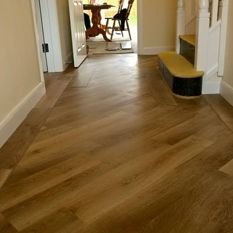885 Vinyl Flooring
Flooring is an important and significant investment in your home, and vinyl flooring is a viable, affordable, and customisable alternative to hardwood, tile, and stone. More
Style
Popular Today
Like any kind of flooring, you need to evaluate your lifestyle before deciding which type of vinyl is best for you. How long do you want this flooring to last? Do you have any children, pets, or extremely high traffic areas? Do you need something that wears well? Or something that is stain resistant and easy to clean? Consider what is a priority to you, and what will also be practical. Also, read the warranty carefully before purchasing and installing a vinyl floor. For some warranties, professional installation is necessary. For others, certain types of scuffs, stains, and indents may not be covered.
Vinyl No-Wax: This is the original wear surface material for vinyl. It resists scuffs and scrapes, and has some stain resistant properties. It’s probably the weakest out of all of the vinyl floor wear surfaces, and was once used on almost all vinyl floors. Now it’s mostly used on entry level base grade floors, since it also requires occasional floor polishing for upkeep.
Urethane (PVC): The next level up in wear surfaces, urethane does a much better job at resisting wear than vinyl no-wax. It tends to retain its look much longer, and resists stains and scuffs.
Enhanced Urethane: The final development in vinyl floor wear surfaces, enhanced urethane has several levels, and some are better at resisting wear than others. The best of these options resist soil and dirt, and won’t stain from normal household materials. For a quality enhanced urethane, cleaning won't entail much more than a broom and occasional mopping.
It’s important to pay attention to the structure of a vinyl floor. How the floor is constructed will determine its durability, and how it will stand up to normal household use. Vinyl floors are usually made in one of two ways:
Rotogravure/Printed Floor Process: These floors are made in a similar process to laminate flooring. A photo is taken of a surface or texture at a high resolution, and then placed under the wear layer for visual appeal.
Inlaid Floors: Instead of using a high resolution photograph, inlaid floors achieve a coloured and textured surface by placing tiny vinyl granules from the backing, and forcing them all the way up to the wear surface. This creates an extremely durable floor, because the colour goes through the material from the bottom to the top, making chips and scrapes less noticeable.
Vinyl flooring usually comes in a single sheet, or in tiles and planks. Both of these can be installed in several manners:
Glued: Sheets and tiles are glued down to the subsurface with a special adhesive.
Floating: The vinyl isn’t actually attached to the subsurface. It just lays on the floor with some tape at the edges. This type of flooring is usually made stiffer with a fibreglass backing.
Self-adhesive: This usually comes in the forms of peel and stick tiles, and is particularly easy to install on your own.
What type of vinyl floors are there?
Vinyl No-Wax: This is the original wear surface material for vinyl. It resists scuffs and scrapes, and has some stain resistant properties. It’s probably the weakest out of all of the vinyl floor wear surfaces, and was once used on almost all vinyl floors. Now it’s mostly used on entry level base grade floors, since it also requires occasional floor polishing for upkeep.
Urethane (PVC): The next level up in wear surfaces, urethane does a much better job at resisting wear than vinyl no-wax. It tends to retain its look much longer, and resists stains and scuffs.
Enhanced Urethane: The final development in vinyl floor wear surfaces, enhanced urethane has several levels, and some are better at resisting wear than others. The best of these options resist soil and dirt, and won’t stain from normal household materials. For a quality enhanced urethane, cleaning won't entail much more than a broom and occasional mopping.
How are vinyl floors made?
It’s important to pay attention to the structure of a vinyl floor. How the floor is constructed will determine its durability, and how it will stand up to normal household use. Vinyl floors are usually made in one of two ways:
Rotogravure/Printed Floor Process: These floors are made in a similar process to laminate flooring. A photo is taken of a surface or texture at a high resolution, and then placed under the wear layer for visual appeal.
Inlaid Floors: Instead of using a high resolution photograph, inlaid floors achieve a coloured and textured surface by placing tiny vinyl granules from the backing, and forcing them all the way up to the wear surface. This creates an extremely durable floor, because the colour goes through the material from the bottom to the top, making chips and scrapes less noticeable.
How is vinyl flooring installed?
Vinyl flooring usually comes in a single sheet, or in tiles and planks. Both of these can be installed in several manners:
Glued: Sheets and tiles are glued down to the subsurface with a special adhesive.
Floating: The vinyl isn’t actually attached to the subsurface. It just lays on the floor with some tape at the edges. This type of flooring is usually made stiffer with a fibreglass backing.
Self-adhesive: This usually comes in the forms of peel and stick tiles, and is particularly easy to install on your own.
This website uses cookies. By continuing you agree to their use. Learn more



































